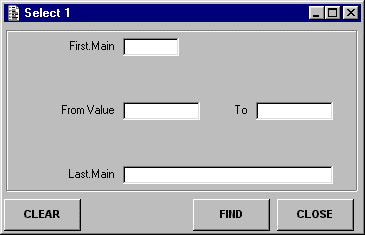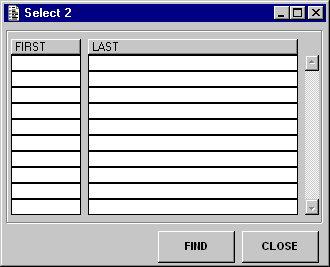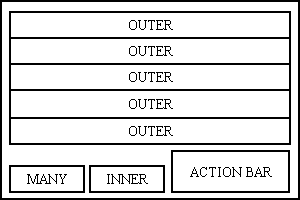


 |
Main Index
PREV
NEXT


|
This type of form is an extension of the profile area defined at the top of a LIST 1 form. It is used when the selection criteria for data retrieval contains more data items that can fit comfortably into the single-line profile area. This is also useful when it is required to specify ranges of values for a single field on the database - in this type of form separate fields can be shown for the "from" and "to" values.
Starting values for the screen can be specified by adding them to the transaction's definitions on the Menu database - please refer to Menu and Security System User Guide - Extra Parameters for more details.

For an overview of all Selection forms please go here.
This type of form can be used in the following ways:-
The user then enters whatever selection criteria are required and presses the FIND button. Any validation (such as checking for valid ranges in the "from" and "to" values) takes place before control is passed back/forward to the LIST form.
| CLOSE | Will return to the parent form with a blank profile. |
| FIND | The action taken depends on the contents ov $CHILD_FORM$:-
In either case it will be the responsibility of the form which receives the selection criteria to actually retrieve the data from the database. |
| CLEAR | This will clear the contents of all fields on the current screen, allowing a different profile to be defined. |
| Source Entity | Source Field | Target Entity | Target Field |
|---|---|---|---|
| ACTION_BAR.INF | CLEAR | ACTION_BAR.INF | CLEAR |
| FIND | FIND | ||
| CLOSE | CLOSE | ||
| MAIN | FIRST | ||
| LAST |
| Name | Expression | Description |
|---|---|---|
| FORM_VERSION | 01.000.000 | To be incremented each time the component is changed. |
| Name | Description |
|---|---|
| FORM_VERSION | |
| PARAMS | |
| CHILD_FORM | The value is defined on the Menu database - refer to Menu and Security System User Guide - Extra Parameters for more details. |

For an overview of all Selection forms please go here.
This type of form is used as the parent to a LIST 4 form. Instead of just passing the retrieve profile to the LIST form it will retrieve the occurrences, construct an XML stream, then pass this XML stream to the LIST form. The XML stream can be loaded and displayed without the need for futher database access.
This is necessary because the retrieve profile is specified on ENTITY A, but the details to be displayed come from ENTITY B. The complication lies in the fact that there is no direct relationship between these two entities, as shown in figure 1.
Figure 1 - Entity A is not directly related to Entity B

The primary key of the XREF entity is actually a combination of the primary keys from ENTITY A and ENTITY B. This means that only one occurrence of XREF can exist for a combination of primary key A and primary key B.
In this type of form the structure of the entities is as shown in Figure 2.
Figure 2 - Component structure

Upon initial entry to this function there will be an automatic retrieve of the OUTER entity. Only occurrences of OUTER are displayed on the form.
The user selects an occurrence of OUTER and pressed the FIND button. This retrieves associated occurrences of MANY, and for each occurrence of MANY it uses the foreign key of INNER to construct a hitlist of INNER entities. When this is complete it passes the hitlist of INNER entities as an XML stream to the form nominated in $CHILD_FORM$.
| FIND | Will activate the LOAD_STREAM operation of the component identified in $CHILD_FORM$. |
| CLOSE | Will return to the parent form with a blank profile. |
| Source Entity | Source Field | Target Entity | Target Field |
|---|---|---|---|
| ACTION_BAR.INF | FIND | ACTION_BAR.INF | FIND |
| CLOSE | CLOSE | ||
| OUTER | FIRST | ||
| LAST | |||
| MANY | N/A | N/A | |
| INNER | N/A | N/A |
| Name | Expression | Description |
|---|---|---|
| FORM_VERSION | 01.000.000 | To be incremented each time the component is changed. |
| Name | Description |
|---|---|
| FORM_VERSION | |
| PARAMS | |
| CHILD_FORM | The value is defined on the Menu database - refer to Menu and Security System User Guide - Extra Parameters for more details. |
| DTD_NAME | This can either be defined in local proc LP_INITIALISE or defined in the Extra Parameters area in the Menu database. |
 |
http://www.tonymarston.net |